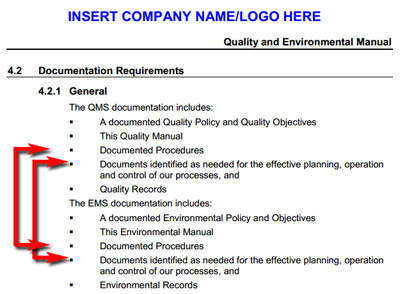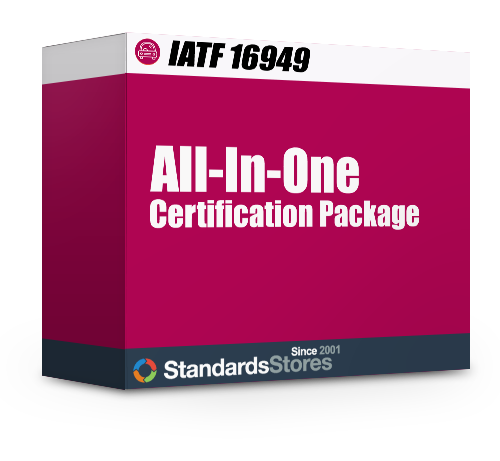IATF 16949:2016 in Detail:
What is the Annex L Platform?
Annex L (originally called Annex SL, then renamed in 2019 to Annex L) is a management system format that helps streamline creation of new standards, and make implementing multiple standards within one organization easier.
It replaces ISO’s Guide 83, which provided a base structure and standardized text for management system standards (MSS). Guide 83 started to address complaints that many have when integrating current MSS like ISO 9001, ISO 14001 and ISO 27001. While these standards have common elements, they are described and organized differently, making it difficult for organizations to implement multiple standards.
“Annex L” further addresses these issues by creating a “template” upon which ISO MSS are to be built in the future. Written primarily as a guide to those who draft the standards, the core of Annex L consists of 8 clauses and 4 appendices that encompass a “high level structure” (essentially shared high level concepts among standards), shared terms/definitions and actual shared clause titles and text. Examples of “high level structure” covered by Annex L include areas ranging from support to operations, and leadership to planning.
Building Standards Specificity On Annex L’s Mandated Structure
Annex L solves the problem of potential redundancy in basic structure for companies wishing to deploy multiple standards. It requires that a time/effort-saving common structure be used for recurring quality management standard elements. But it allows more specifics to be added for a given area of expertise, i.e. environmental or health and safety.
Who Created Annex L?
Annex L is a product of the ISO Technical Management Board’s (TMB) Joint Technical Coordination Group (JTCG). The TMB is charged with managing the technical processes associated with implementing new technical standards. This includes the rules which govern standards creation, checking how the process is working, and managing the technical committees which construct the standards. The JTCG reports to the TMB and specifically manages the activities associated with creating and implementing an MSS. One of its main tasks is to ensure that the input from the various technical committees associated with each standard are represented in the resulting MSS of a given area (i.e. environmental, aerospace, etc.)
Why is Annex L Being Implemented in Standards like ISO 9001:2015?
Annex L will save any organization seeking to adopt MSS time and cost. Because standards such as ISO 9001 and ISO 14001 have similar intents but different structures, text and terminology, they are more difficult to implement together. And while there are tools such as our own integrated standards documentation* (which helps eliminate this duplication effort by creating an Integrated Management System or IMS), there has been a call to streamline the certification process for multiple standards adoption. In addition, there is an opportunity for ISO to infuse new concepts across multiple MSS. These concepts include enfranchising customers, suppliers and impacted communities into the quality process; the shift toward service-oriented businesses; and the extension of digital aids to serve what are often geographically and organizationally dispersed workgroups.
An IMS can streamline a businesses operations by merging different areas of compliance. For example, combining quality, environmental and safety into a single IMS requires less resources and is more likely to succeed than maintaining separate management systems for each. Standards can either be combined or integrated. An Integrated Management System integrates two or more standards from different disciplines into one. (example: ISO 9001, ISO 14001, ISO 45001)
A Combined Management System combines two more standards from the same discipline into one. (example: ISO 9001, AS9100) Companies visiting our IMS website Integrated-Standards.com often request combinations of standards such as:
- Quality Management
- ISO 9001 (General Quality Management Systems
- ISO 13485 (Medical Devices)
- TS 16949 (Automotive)
- AS9100 (Aircraft, Space & Defense))Environmental Management
- ISO 14001 (Environmental Management Systems)
- Safety Management
- OHSAS 18001 (Occupational Health & Safety)
Rather than just creating parallel systems, true integration means that similar processes are implemented without duplication or confusion. IMS elements that exist in each system are treated as common resources. They are defined, deployed and managed in the same manner and do not have to deal with multiple, often slightly different interpretations of their roles in executing each standard. Annex L should make creation of an IMS much easier.
Annex L: Features/Benefits
As noted, there are many reasons for management system standards (MSS) writers to adopt the foundational Annex L, including:
- Eliminating conflicts in MSS platforms
- Faster development of standards
- Less duplication of concepts, terms and potentially shared text
- Less low value revisions to common or shared areas
- Integrating high level, common business management goals, issues, needs
Annex L addresses these needs by alignment of similar clauses. This, in turn, fosters easier integration by adopting similar formats and similar terms and definitions. In addition, Annex L addresses key high level components which are being driven by market forces such as:
Risk Management
Annex L now elevates the preventive and corrective action concept into a more encompassing risk assessment process. It proactively wants risks to be anticipated and addressed in the planning phase, not as something to which one reacts. Essentially, it asks the organization to use the inputs it has gained, add its experience and provide a reasonable analysis of risks and successful responses to them. It also asks for a more measurable approach to planning, using metrics of what will be attained that are meaningful to support implementation.
Accessible Documentation
Recognizing the reality of more modern methods of information dissemination, Annex L outlines additional, specific requirements to both document and communicate the quality management system. An example is making sure that there are true work instructions written down for everyone in the organization, even if a set of tasks seem obvious. The idea is reasonable since documentation not only helps maintain consistency of tasks between workers, it helps the organization plan for growth in adding or replacing resources. This expanded approach to documentation is meant to allow and support other means of viewing, storing, revising and distributing documentation such as via internal and external networks (i.e. cloud computing) and wider array of formats.
Wider Involvement
Annex L asks standard drafters to consider the “Context of the Organization.” This requires the company (and the auditors who are being asked to certify their quality system) to listen not only to customers, employees and suppliers, but to those who their operations may also affect such as the communities in which they operate or have significant influence. Quality planning then becomes a broader search to uncover potentially relevant issues that may impact operations, and the development of a quality policy for a “newer age” – for instance as a deeper information base to decide how risks might be better anticipated.
How Annex L Works
Annex L seeks to balance the need for adding rules that may need to be more specific for a given area, with keeping the overall structural redundancy to a minimum. As such, its terms and definitions can be added to, but can’t be deleted or changed. For example, here’s a section from one draft of the ISO/IEC group working on the ISO 9001 Revision:
Forward
“Comments received on the Annex L common text and High Level Structure will not be considered by WG 24 for the development of this Working Draft. Any such comments that are received will be directed to ISO/TC 176/SC2/AHG 03 ‘Input into the JTCG’ for consideration for forwarding to the JTCG during any future revision of Annex L (for which there are no plans at this time). Comments for additions to the Annex L common text or High Level Structure will be considered, provided that the additional text does not contradict or undermine the intent of the Annex L text.”
– Copyright ISO 2012 – All rights reserved by ISO/WD 9001
When will Annex L Take Effect?
ISO 9001-2015 will not be the first ISO management standard to employ Annex L, nor will it be the last. But it may be the most significant to date. This means it has survived the scrutiny of half a dozen technical committees and may be ready for the wider use that the newest ISO 9001 update will bring. The following is a list of standards that already employ Annex L.
- ISO/IEC 27001, Information technology: Security techniques, Information security management systems
- ISO 30301:2011, Information and documentation: Management systems for records
- ISO 22301:2012, Societal security: Business continuity management systems
- ISO 20121:2012, Event sustainability management systems
- ISO 39001, Road-traffic safety (RTS) management systems ISO 55001, Asset management (Currently on CD ballot with publication scheduled for 2014 and in line with Annex L)
The following are ISO management standards which are slated at this point to employ the Annex L foundation:
- ISO 9001:2015 (General Quality Management)
- ISO 14001 (Also expected in 2015)
- ISO 13485 (Currently under revision)
And there are some sectors that have yet to decide upon implementing revisions based on Annex L including:
- International Automotive Task Force (IATF) – ISO/TS 16949
- International Aerospace Quality Group (IAQG) – AS9100/10/20
- British Standards Institute (BSI) – OHSAS 18001
How We Will Use Annex L to Help You
An example of Annex L’s potential may be seen in examples of how documents might be more easily managed. For example, our Integrated Standards store specializes in providing the basic documents that those seeking multiple standards certification can tailor to their needs. Using ISO 14001 and ISO 9001 as an example, here are the clauses where we see significant current overlap:
| Red = Shared Requirement | ISO 14001:2004 | ISO 9001:2008 |
|---|---|---|
| General Requirements | 4.1 | 4.1 |
| Policy | 4.2 | 5.3 |
| Environmental Aspects | 4.3.1 | – |
| Hazard Identification, Risk Assessment and Determining Controls | – | – |
| Legal and other Requirements | 4.3.2 | – |
| Objectives, Targets and Programs | 4.3.3 | 5.4.1, 5.4.2 |
| Resources, Roles, Responsibility, (Accountability) and Authority | 4.4.1 | 5.5.1, 5.5.2, 6.1 |
| Competence, Training and Awareness | 4.4.2 | 6.2.1, 6.2.2 |
| Communication | 4.4.3 | 5.5.3 |
| Participation and consultation | – | – |
| Documentation | 4.4.4 | 4.2.1, 4.2.2 |
| Control of Documents | 4.4.5 | 4.2.3 |
| Operational Control | 4.4.6 | – |
| Emergency Preparedness and Response | 4.4.7 | – |
| Monitoring and Measurement | 4.5.1 | 7.6, 8.2.3, 8.2.4 |
| Evaluation of Compliance | 4.5.2 | – |
| Incident Investigation | – | – |
| Nonconformity, Corrective Action and Preventive Action | 4.5.3 | 8.5.2, 8.5.3 |
| Control of Records | 4.5.4 | 4.2.4 |
| Internal Audit | 4.5.5 | 8.2.2 |
| Management Review | 4.6 | 5.6 |
On a practical level, Annex L could help improve and streamline this combination process that has already been started through our IMS efforts. We see the potential for further combining and streamlining joint sections. Below is an example from our ISO 9001-14001 All In One Certification Package that combines the documents we provide into one easy to execute bundle. As you can see, there are sections that are virtually identical, which are required by both standards that could be further rationalized through a program like Annex L.
Integrated-Standards.com has many tools that essentially help eliminate this type of duplication between current ISO standards for companies wishing to implement an Integrated Management System that integrates two or more standards from different disciplines into one such as ISO 9001 (Quality), ISO 14001 (Environmental), OHSAS 18001 (Safety).
Past (Obsolete) versions of ISO 9001 Standard include:
- ISO 9001:2000 was replaced ISO 9001:2008 in the year 2008
- What changed from 9001:2000 to ISO 9001:2008?
- ISO 9001:1994 had three versions:
- ISO 9001:1994 – Manufacturing with Design & Development
- ISO 9002:1994 – Production and Installation (No Design)
- ISO 9003:1994 – Final inspection and test




